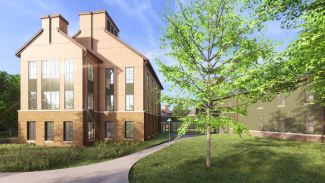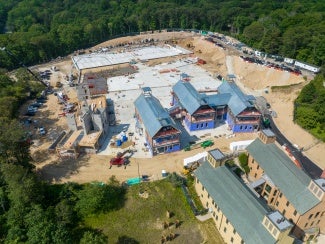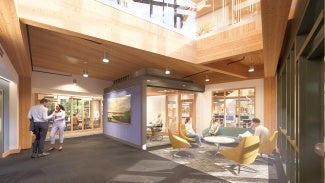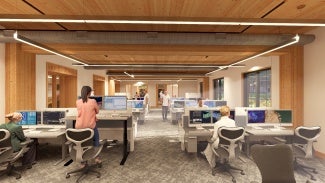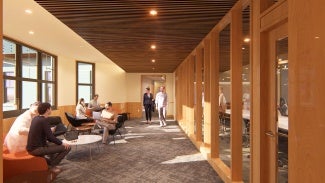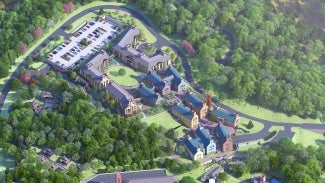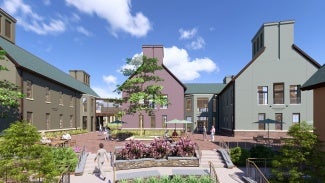
A restorative future for Cold Spring Harbor Laboratory
The venerable research institution is undergoing a historic campus expansion.
Cold Spring Harbor Laboratory (CSHL) is a biological research institution par excellence. Its Foundations for the Future expansion project will make it even better.
Located on Long Island in Laurel Hollow and Cold Spring Harbor, New York, CSHL’s 110-acre campus includes the oldest operating laboratory in the country. Key advances in neuroscience, molecular genetics, cell biology, and cancer research have occurred within CSHL’s facilities. Its educational programs serve tens of thousands of people—from scientists to teachers—each year. Eight Nobel Prize winners have called the institution home, and it is listed on the National Register of Historic Places.
A comprehensive expansion
CSHL continues to build on its rich legacy while acknowledging a problematic era from its past. (More on that later.) Last month, CSHL topped off its new Artificial Intelligence and Quantitative Biology (AIQB) building, a 28,000-square-foot laboratory that will enhance cancer and neuroscience research while providing a home for work in the emerging field of NeuroAI.
Led by Centerbrook Architects and Planners, CSHL’s longtime campus architect, and the construction and development firm Skanska, the AIQB lab’s addition is part of the first phase of CSHL’s $500 million Foundations for the Future campaign. The campaign is a multiyear effort that will eventually comprise a 379,500-square-foot campus expansion. It will add wet labs (which are spaces for experiments involving liquids), conference areas, living accommodations, a two-story parking structure, and more. CSHL expects substantial completion by early 2027.
“As we designed this major expansion, we worked to seamlessly and organically integrate with the existing campus fabric,” said Todd E. Andrews, AIA, Centerbrook’s principal in charge of the project. “The cutting-edge research laboratories and progressive mass timber construction are complemented by the network of exterior spaces that promote serendipitous encounters and interdisciplinary collaboration among scientists across the campus.”
Foundations for the Future represents new investments in conducting “whole body science,” in the words of Steve Monez, CSHL’s chief facilities officer. “Our scientists are looking at what cancer does to the whole body and its impacts on the brain,” he says. “They’re studying [the connections] with known brain diseases like Alzheimer’s and dementia.” This level of comprehensive research demands a sophisticated and interconnected campus where practitioners can “gather and share ideas,” Monez says.
Such an endeavor extends to the land itself. The Foundations for the Future campaign is as much about building on CSHL’s institutional legacy as it is fortifying the coastal campus against increasingly volatile climate conditions. Restoration and resilience are key components of CSHL’s future.
Restoration and resilience
Operations at CSHL date back to 1890. A year prior, whaling scion John D. Jones donated eight acres of land, once occupied by his family’s Cold Spring Harbor Whaling Company, to the Brooklyn Institute of Arts and Sciences. That organization later founded CSHL’s forerunner, the Biological Laboratory.
Still standing today, next to the water of the inner harbor, is the modest but stately Jones Laboratory, the oldest operating science lab in the U.S. The timber-frame building is on a slab-like foundation of crushed shell that hovers over an active ground spring, which occasionally floods the surrounding area. Mere feet away, a crumbling 900-foot-long seawall made of granite, originally constructed in the 1850s, initially provided inadequate protection for the Jones Laboratory.
The lab’s precarious setting demanded immediate attention. “One third of [the seawall] was already in the water by the time we got there. It had just collapsed,” recalls Skanska project manager Jonathan Walsh. The prospect of restoring or replacing the seawall drew the attention of the Army Corps of Engineers, the New York State Historic Preservation Office, and the Village of Laurel Hollow, all of whom had varying preferences. In an inspired feat of design-cum-diplomacy, a mix of preservation and new construction commenced.
Crews removed and re-cut the existing stones, then used them to assemble a cast of prefabricated panels around a new seawall of 18-inch reinforced concrete, capped with two feet of additional granite. The renovation also added 400 linear feet of new wall, plus valves and pipe channels to manage the site’s constant downward flow of groundwater, which would otherwise cause erosion. This restorative approach was the “quicker, safer, cleaner” option, Walsh says, and yielded a more harmonious balance between the land and the bay.
Building sustainably on the hillside
The heart of CSHL’s campus sits 180 feet above sea level, meaning it doesn’t face the same threat from water as the Jones Lab. Still, the institution is taking steps to ensure the central campus endures, too. That involves building to last and building for health, in a manner that honors the built character of the existing campus.
The understated Georgian-esque form and massing of CSHL’s new conjoined lab buildings, which include the three-story AIQB building, are identical to their campus brethren. Architectural solidarity and adherence to zoning requirements were priorities during design development.
CSHL also maintains its own sewage system, which connects to the municipal system via four and a half miles of pipe. Monez says of the campus, “It’s meant to be a village. … [T]he laboratory is trying to be a good steward of the ground and harbor around us.”
The AIQB lab deviates from the past in its use of mass timber. Glulam columns and beams plus cross-laminated timber floor decks comprise the AIQB’s superstructure. The lumber came from the southeastern U.S. and underwent milling principally at SmartLam’s facility in Dothan, Alabama. The CSHL project’s initial intention was to use wood from the northeastern U.S., but supply chain issues necessitated sourcing it from farther away. Even with that shift, CSHL and Skanska minimized the project’s overall embodied carbon by working with other domestically and regionally sourced building materials.
Monez highlights CSHL CEO Bruce Stillman’s eye for detail and desire for long-term stability. “He really cares about what this place is going to look like long term. We went through a lot of different renderings. We looked at how ductwork is going to be exposed [and] what parts of the natural timber will be exposed. It has exceeded all expectations.”
Acknowledging a troubled legacy
While CSHL is building on an illustrious past, not every episode of its history is worth celebrating. Starting in 1910, the institution was home to the Eugenics Record Office (ERO), a research group that pushed racist ideologies as scientific fact. The ERO promoted sterilization laws, its leaders supported the “race hygiene movement,” and the office’s findings were leveraged by the U.S. government in 1924 as part of its efforts to limit immigration. By the late 1920s, geneticists began rejecting eugenics research, labeling it as baseless pseudoscience and propaganda. In 1939, the ERO disbanded after revelations that the Nazis had adopted its work.
CSHL has elected not to hide this scar. The full historical records of the ERO are housed in the laboratory’s archives, living on as a cautionary tale for when ideologues pervert science.
“Here to stay for the long term”
Through the good and bad, Cold Spring Harbor Laboratory knows its history. The institution’s collective research output has transformed modern medicine and guides how the medical community diagnoses and treats cancer. At the same time, CSHL’s ongoing campaign to more than double its built footprint reflects a desire to chart a restorative and innovative future. Projects like the restored seawall in Cold Spring Harbor, recent renovations to the Jones Laboratory, and the newly built AIQB lab are evidence of this. “We want to make sure that we’re here to stay long term,” Monez says.
Justin R. Wolf is a freelance writer covering architecture and design. He lives in Maine.

